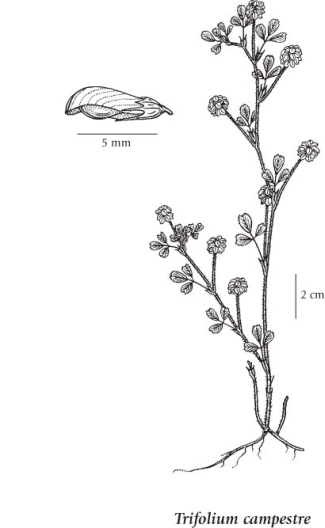Trifolium campestre Schreb.
low hop-clover (field clover)
Fabaceae (Pea family)
Introduction to Vascular Plants
low hop-clover (field clover)
Fabaceae (Pea family)
Introduction to Vascular Plants
Species Information
General:
Annual herb from a taproot; stems several, trailing to ascending, short-hairy, 10-35 cm long/tall.
Leaves:
Alternate, somewhat pinnately compound; leaflets 3, egg- to wedge-shaped, 5-15 mm long, the stalk of the terminal leaflet at least twice as long as those of the lateral leaflets; stipules egg-shaped, 4-9 mm long, joined to the leaf-stalk for 1/2 their length, the free tips triangular.
Flowers:
Inflorescence a dense, egg- to globe-shaped, axillary head of 30 to 100 drooping, pea-like flowers, the heads about 12 mm wide, lacking involucres; corollas yellow, becoming brown, 4-6 mm long, the banner broad, longer than the wings and keel; calyces 1/2 as long as the corollas, glabrous, 5-veined.
Fruits:
Pods, egg-shaped, about 2 mm long; seeds 1 or 2.
Illustration

If more than one illustration is available for a species (e.g., separate illustrations were provided for two subspecies) then links to the separate images will be provided below. Note that individual subspecies or varietal illustrations are not always available.
Illustration Source: The Illustrated Flora of British Columbia
Habitat and Range
Mesic to dry roadsides, fields and waste places in the lowland zone; frequent in SW BC; introduced from Eurasia.Status Information
Synonyms
Synonyms and Alternate Names:
Trifolium procumbens L. 1755, non 1753